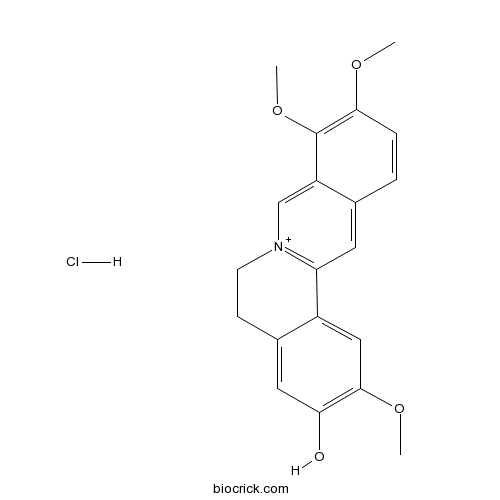Jatrorrhizine HydrochlorideCAS# 960383-96-4 |

- Jatrorrhizine chloride
Catalog No.:BCN4956
CAS No.:6681-15-8
Quality Control & MSDS
3D structure
Package In Stock
Number of papers citing our products

| Cas No. | 960383-96-4 | SDF | Download SDF |
| PubChem ID | 21115138 | Appearance | Powder |
| Formula | C20H21ClNO4 | M.Wt | 374.8 |
| Type of Compound | N/A | Storage | Desiccate at -20°C |
| Solubility | Soluble in Chloroform,Dichloromethane,Ethyl Acetate,DMSO,Acetone,etc. | ||
| Chemical Name | 2,9,10-trimethoxy-5,6-dihydroisoquinolino[2,1-b]isoquinolin-7-ium-3-ol;hydrochloride | ||
| SMILES | COC1=C(C2=C[N+]3=C(C=C2C=C1)C4=CC(=C(C=C4CC3)O)OC)OC.Cl | ||
| Standard InChIKey | JKMUUZMCSNHBAX-UHFFFAOYSA-O | ||
| Standard InChI | InChI=1S/C20H19NO4.ClH/c1-23-18-5-4-12-8-16-14-10-19(24-2)17(22)9-13(14)6-7-21(16)11-15(12)20(18)25-3;/h4-5,8-11H,6-7H2,1-3H3;1H/p+1 | ||
| General tips | For obtaining a higher solubility , please warm the tube at 37 ℃ and shake it in the ultrasonic bath for a while.Stock solution can be stored below -20℃ for several months. We recommend that you prepare and use the solution on the same day. However, if the test schedule requires, the stock solutions can be prepared in advance, and the stock solution must be sealed and stored below -20℃. In general, the stock solution can be kept for several months. Before use, we recommend that you leave the vial at room temperature for at least an hour before opening it. |
||
| About Packaging | 1. The packaging of the product may be reversed during transportation, cause the high purity compounds to adhere to the neck or cap of the vial.Take the vail out of its packaging and shake gently until the compounds fall to the bottom of the vial. 2. For liquid products, please centrifuge at 500xg to gather the liquid to the bottom of the vial. 3. Try to avoid loss or contamination during the experiment. |
||
| Shipping Condition | Packaging according to customer requirements(5mg, 10mg, 20mg and more). Ship via FedEx, DHL, UPS, EMS or other couriers with RT, or blue ice upon request. | ||

Jatrorrhizine Hydrochloride Dilution Calculator

Jatrorrhizine Hydrochloride Molarity Calculator
| 1 mg | 5 mg | 10 mg | 20 mg | 25 mg | |
| 1 mM | 2.6681 mL | 13.3404 mL | 26.6809 mL | 53.3618 mL | 66.7022 mL |
| 5 mM | 0.5336 mL | 2.6681 mL | 5.3362 mL | 10.6724 mL | 13.3404 mL |
| 10 mM | 0.2668 mL | 1.334 mL | 2.6681 mL | 5.3362 mL | 6.6702 mL |
| 50 mM | 0.0534 mL | 0.2668 mL | 0.5336 mL | 1.0672 mL | 1.334 mL |
| 100 mM | 0.0267 mL | 0.1334 mL | 0.2668 mL | 0.5336 mL | 0.667 mL |
| * Note: If you are in the process of experiment, it's necessary to make the dilution ratios of the samples. The dilution data above is only for reference. Normally, it's can get a better solubility within lower of Concentrations. | |||||

Calcutta University

University of Minnesota

University of Maryland School of Medicine

University of Illinois at Chicago

The Ohio State University

University of Zurich

Harvard University

Colorado State University

Auburn University

Yale University

Worcester Polytechnic Institute

Washington State University

Stanford University

University of Leipzig

Universidade da Beira Interior

The Institute of Cancer Research

Heidelberg University

University of Amsterdam

University of Auckland

TsingHua University

The University of Michigan

Miami University

DRURY University

Jilin University

Fudan University

Wuhan University

Sun Yat-sen University

Universite de Paris

Deemed University

Auckland University

The University of Tokyo

Korea University
- ONX-0914 (PR-957)
Catalog No.:BCC2095
CAS No.:960374-59-8
- Meropenem
Catalog No.:BCC2489
CAS No.:96036-03-2
- Vortioxetine (Lu AA21004) HBr
Catalog No.:BCC1213
CAS No.:960203-27-4
- SD 1008
Catalog No.:BCC2442
CAS No.:960201-81-4
- 2-hexyl-4-Pentynoic Acid
Catalog No.:BCC6480
CAS No.:96017-59-3
- Mepivacaine
Catalog No.:BCC9020
CAS No.:96-88-8
- Aminothiazole
Catalog No.:BCC4623
CAS No.:96-50-4
- Guajadial
Catalog No.:BCN4509
CAS No.:959860-49-2
- CH5138303
Catalog No.:BCC5364
CAS No.:959763-06-5
- Guggulsterone Z
Catalog No.:BCN3793
CAS No.:95975-55-6
- TC-E 5005
Catalog No.:BCC6227
CAS No.:959705-64-7
- 5,7,4-Trihydroxy-3,6-dimethoxy-3-prenylflavone
Catalog No.:BCN1297
CAS No.:959421-20-6
- ent-17-Hydroxykauran-3-one
Catalog No.:BCN4510
CAS No.:960589-81-5
- Massoniresinol
Catalog No.:BCN4511
CAS No.:96087-10-4
- Stylopine hydrochloride
Catalog No.:BCN6964
CAS No.:96087-21-7
- 2'-Deoxyguanosine
Catalog No.:BCC5433
CAS No.:961-07-9
- Isoliquiritigenin
Catalog No.:BCN4512
CAS No.:961-29-5
- MPEP
Catalog No.:BCC4594
CAS No.:96206-92-7
- Epidermal Growth Factor Receptor Peptide (985-996)
Catalog No.:BCC1014
CAS No.:96249-43-3
- Methyl 8-hydroxy-3-(2-methoxy-2-oxoethyl)-6-methyl-9-oxo-9H-furo[3,4-b]chromene-1-carboxylate
Catalog No.:BCN7465
CAS No.:96287-41-1
- Androst-2-en-17-one
Catalog No.:BCC8821
CAS No.:963-75-7
- Huzhangoside D
Catalog No.:BCN2527
CAS No.:96315-53-6
- Metaphit
Catalog No.:BCC5664
CAS No.:96316-00-6
- Neonuezhenide
Catalog No.:BCN7461
CAS No.:96382-91-1
Jatrorrhizine Hydrochloride Suppresses Proliferation, Migration, and Secretion of Synoviocytes In Vitro and Ameliorates Rat Models of Rheumatoid Arthritis In Vivo.[Pubmed:29783696]
Int J Mol Sci. 2018 May 18;19(5). pii: ijms19051514.
Jatrorrhizine Hydrochloride (JH), an active component isolated from the traditional Chinese herb Coptis chinensis, has been reported to have antimicrobial, antitumor, antihypercholesterolemic, and neuroprotective activities. However, its antirheumatoid arthritis (RA) property remains unknown. In this study, a collagen-induced arthritis (CIA) rat model was used to evaluate the therapeutic effects of JH on RA by using arthritis score, radiological evaluation, and histopathological assessment. The in vitro effects of JH on proliferation, migration, and production of inflammatory mediators in RA-derived fibroblast-like synoviocyte MH7A cells were determined by the EdU incorporation assay, wound healing assay, real-time PCR, and ELISA, respectively. The in vivo studies showed that JH treatment significantly prevented the progression and development of RA in CIA rats through anti-inflammation and suppressing bone destruction. The in vitro studies revealed that JH could effectively attenuate the destructive phenotypes of MH7A cells, including inhibiting proliferation, migration, and production of inflammatory mediators. Further mechanistic analysis demonstrated that JH suppressed tumor necrosis factor alpha (TNFalpha)-stimulated activations of nuclear factor of kappaB (NF-kappaB) and mitogen-activated protein kinases (MAPKs) (ERK and p38) leading to the downregulation of proinflammatory cytokines, which might be beneficial to the antiproliferative and antimigratory activities of FLS cells. Collectively, our results demonstrated that JH has a great potential to be developed into a novel therapeutic agent for treating RA.


